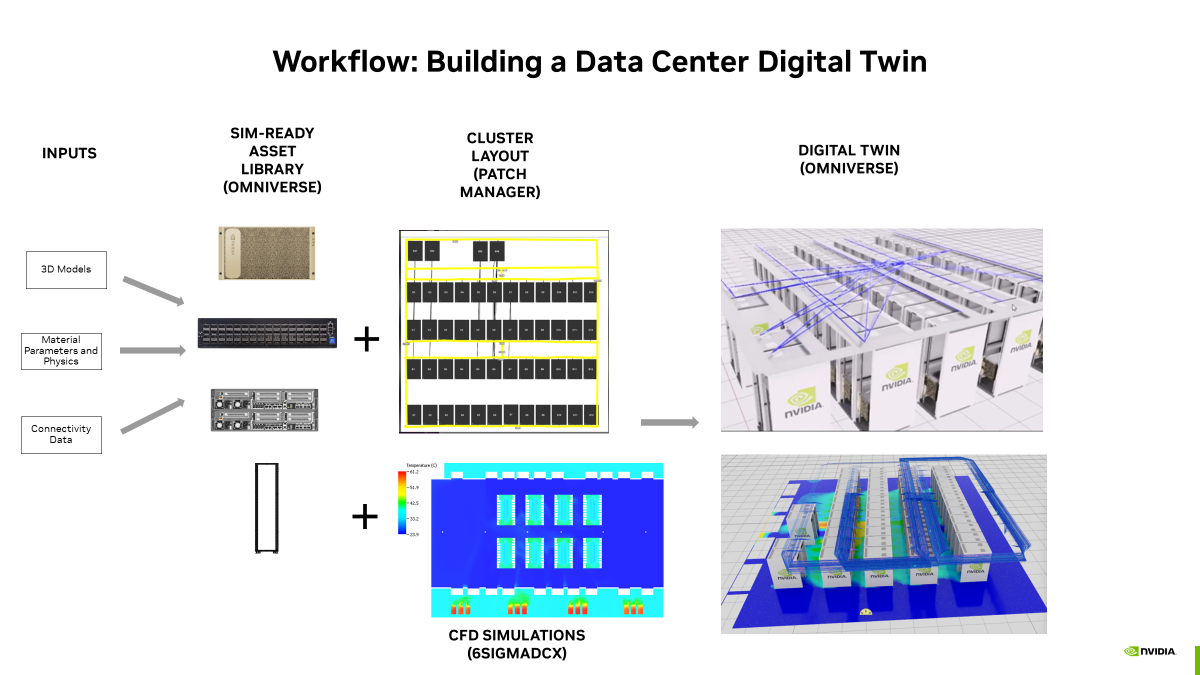Data Center Digital Twins
Overview

Designing a data center is a complex process that happens before the data center is built and operated. It involves creating plans for different systems like space, power, cooling, racks, computer networks, storage, and cabling. All these systems are interconnected and need to work together smoothly to create a reliable and high-performance data center.
Normally, engineers and architects with different skills work on designing these systems using various tools and applications. They collaborate in design sessions, but sometimes there can be problems due to different languages and interfaces used in each area. This can lead to errors in transferring information and inefficiencies that slow down the design process.
With the NVIDIA Omniverse data center digital twin, we have a chance to reduce these risks and make the design process smoother, faster, and more efficient. The upcoming sections will explain how different Kit Extensions can be used for this purpose.
Development Process
Full Fidelity Visualization (3D Rendering)
To create a digital twin, the process begins with visualizing the design in 3D using Omniverse. Engineers responsible for different components of the data center use their preferred tools and applications to create 3D models. These models are then imported into Omniverse in USD format using Connectors or Extensions. Omniverse offers seamless integration with various Architecture/Engineering applications, which you can find in the complete list of Omniverse Connectors.
In the current release, there is a library of pre-designed 3D assets in USD format available for commonly used NVIDIA hardware and supporting infrastructure like the DGX A100 SuperPOD. If your data center uses this hardware, you can directly use the pre-designed USD assets to build the digital twin instead of going through the native tools/applications integration process.
Cluster and Rack Layout Design
Designing the cluster layout is the process of finding the optimal arrangement of IT, network, storage and other hardware into the rack spaces and rows in the data center. The goal of this process is to optimize the performance of the IT cluster while taking into account the available space in the data hall and power/cabling infrastructure needed. Patch Manager is an application that facilitates this design process by using preloaded models of the hardware and enabling cabling design calculations. Once the cluster layout is designed in PATCH MANAGER, it can be easily exported to Omniverse using the Patch Manager Extension.
Thermal Simulation using Computational Fluid Dynamics (CFD)
As the data center floor layout and the compute cluster is being designed as described above, it becomes imperative to ensure that the cooling system design of the data center is optimal for the clusters being deployed. This can be done very effectively by simulating cooling system operation using Computational Fluid Dynamics (CFD) tools. 6SigmaDCX is one of the widely used tools for simulating a data center’s cooling system performance including calculating air flow rates, temperatures and pressure data. Using the 6SigmaDCX connector for Omniverse, the data center digital twin can be exported from Omniverse to 6SigmaDCX to expedite the time to build the DC model leveraging design boundary conditions already built into the Omniverse digital twin such as server hardware properties, floor layout and cluster layout. Once the simulations are complete, they can be imported back into Omniverse to be overlaid into the digital twin in high fidelity visualization.
With CFD simulation data introduced to the digital twin, future capabilities of Omniverse data center digital twins will allow an AI/ML model to be trained on this data as well as the digital twin to be an interface for designers to visualize and evaluate what-if design scenarios.
Summary
The extensions and connectors mentioned above can be used individually to visualize specific aspects of data center design, such as data hall and facility design, cluster layout, and cooling system design. They can however also be combined in a workflow to create a comprehensive digital twin. This allows for step-by-step building of the digital twin and visualizing multiple aspects within a single platform. By utilizing this combined workflow, future capabilities like AI-driven design and operations become possible since the digital twin is integrated with the data imported through these workflows.